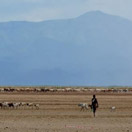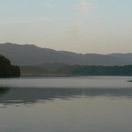Palaeoclimatology

We reconstruct Quaternary climate on orbital and sub-orbital timescales using a range of microfossil, isotopic and biomarker indicators. We have also pioneered numerical analysis of palaeoecological data, and modelling of past climate using ensemble general circulation models (GCM). A particular focus of palaeoclimate reconstructions is on the Asian monsoon system using lake sediment sequences from Japan and the Tibetan Plateau to understand the response of the monsoon to Quaternary climate changes (Andy Henderson & Emma Pearson).
Emma Pearson has been developing the application of novel organic biomarkers to lake sediments and has been instrumental in the calibration of glycerol dialkyl glycerol tetraethers (GDGTs) as quantitative indictors of temperature, and the use of alkenones as salinity and temperature proxies.
Steve Juggins uses a range of novel methods and techniques to analyse palaeoecological datasets, inferring past environmental change and improving biologically-based quantitative reconstructions. His bespoke C2 software is widely used for the analysis of palaeoecological data in over 250 laboratories worldwide.
Hiro Yamazaki was part of the team that designed and implemented the BBC Climate Change Experiment (ClimatePrediction.net), which modelled the upper boundary of future temperature. Hiro Yamazaki has developed of GCM ensembles, especially the application of flux adjustments and parallel computing.
Chew Bahir Project Summary PDF 347Kb

A 500,000 year environmental record from Chew Bahir, south Ethiopia: testing hypotheses of climate-driven human evolution, innovation and dispersal
Lake Suigetsu Project Summary PDF 339Kb

Deciphering timings and rates of abrupt climate changes over the Lateglacial-Holocene period: The Lake Suigetsu biomarker record